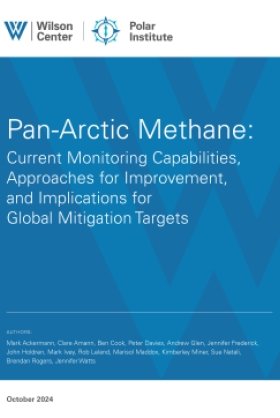Pan-Arctic Methane: Current Monitoring Capabilities, Approaches for Improvement, and Implications for Global Mitigation Targets



The Arctic has been warming three to four times faster than the global average for several decades. Rapid warming is driving a wide range of impacts at multiple scales: not only damage to ecosystems and human wellbeing in the Arctic—such as the local impacts from permafrost thaw and sea-ice retreat, altered abundance of economically and culturally important species, and wildfires increasing in coverage and intensity—but also far-reaching disruptions. Global effects of Arctic warming include changes to Northern Hemisphere climate patterns, global sea-level rise, and toxic smoke from Arctic wildfires.
Worryingly, as the Arctic region changes, ecosystems that have historically served as carbon sinks, such as wetlands and forests, may emerge as sources of carbon emissions. Indeed, it is quite possible that the most important global impact of rapid Arctic warming over the next few decades will come from the emissions of carbon dioxide (CO2) and methane (CH4) from thawing permafrost. The amount of carbon in Arctic soils is about twice the amount currently in the atmosphere, and most of that carbon is in organic matter frozen in permafrost.
As permafrost soils thaw, the existing cold-adapted microbial community is strongly affected by warmer temperatures, higher soil water content from melted ground ice, and increased nutrient availability from deeper rooting vegetation. These environmental changes alter the ecological conditions of the soil microbiome, accelerating the decomposition of organic carbon into carbon dioxide and methane.
The effect that changes in Arctic permafrost soils will ultimately have on the global climate depends on several factors. These include not only the speed of permafrost thaw, but also other processes: other environmental factors that affect the speed of microbial action; how much of the mobilized carbon is released to the atmosphere; the proportion of the release that is methane versus carbon dioxide; and how much of this release is offset by increased plant biomass in a “greening Arctic.”
Although the potential importance of emissions from permafrost to the global climate future is clear, permafrost thaw is largely absent from global earth system models. When included at all, only linear (gradual, top-down) thaw has been represented. Rapid thaw caused by thermokarst (disruptive permafrost thaw), hill slope collapse, wildfires, and other nonlinear phenomena, which are occurring with increasing frequency, are not modeled. This under-representation of potential permafrost-thaw contributions in the models being used to inform deliberations about national and global climate policies compromises the ability to effectively achieve goals.
Methane’s high impact on global climate over the next few decades is reflected in scientific estimates that assign about a third of the projected global climate impact in the current century from thawing permafrost to methane. That projection motivates a closer look at the state of scientific understanding of methane’s contribution, which historically has received less attention than that of carbon dioxide. But a further motivation is that the uncertainties surrounding the potential emissions of methane from Arctic ecosystems are even larger than the uncertainties around carbon dioxide emissions. That’s true in part because of poorly documented soil conditions—including depth of ground thaw, ground saturation, and carbon and nutrient content— which drive methane production, consumption, and, thus, net emissions. Also contributing to large uncertainty about future methane emissions from permafrost are the rates and patterns of emissions from freshwater ecosystems, which are thought to account for approximately half of current global methane emissions. These processes are largely undocumented in the Arctic. Finally, the uncertainties around methane emissions in marine environments—that is, from subsea permafrost and shallow methane clathrates—are even larger than the uncertainties on the terrestrial side.
Clearly, then, a more rigorous understanding of methane release mechanisms and lifecycle, permafrost distributions, and changes in thaw rates must be a high priority for better understanding global climate change. Gaining that understanding will require both more accurate estimates of current emissions from the Arctic and more realistic Earth System Models (ESMs).
In practice there is no optimized or coherent global methane monitoring architecture. Given the vastness of the Arctic, there are constraints on ground and aerial measurements that necessitate better leveraging of space-based systems and sensors, including to fill some of the data gaps resulting from disrupted scientific cooperation with Russia following its 2022 full-scale invasion of Ukraine.
To improve the estimate of methane fluxes, it is imperative to accelerate the development of internationally coordinated effective pan-Arctic satellite monitoring capabilities that incorporate active sensors and use optimal orbits to maximize view durations in the Arctic. While providing valuable data, satellite-based methane monitoring in the Arctic region has multiple challenges and significant limitations due to geometry, geography, and orbital dynamics.
Ground-level methane measurements in the Arctic are critical for monitoring and process-level understanding, but present technical and logistical challenges given the large size, harsh winter climate, and relative inaccessibility of much of the Arctic. Extrapolating ground-based methane measurements vertically into the atmosphere requires collaborative research to couple ground-based and aerial measurements.
Permafrost emission processes vary with ecosystem type, leading to large heterogeneity in Arctic methane emissions and uncertainty in future methane emission projections. Another challenge in understanding and predicting permafrost emissions is predicting ecosystem transition and associated greenhouse gas releases under different climate scenarios.
A key capability that will significantly improve methane (and carbon dioxide) monitoring data quality, as well as the means to integrate data for regional scale analysis, will be the ability to cross-calibrate data products from different types of methane sensors. Cross-calibration will enable significantly more accurate comparison of data across a wide range of satellite and airborne sensors, which in turn will greatly strengthen data fusion and integration at basin and regional scales. Significant additional work is needed to strengthen systems-level upscaling and integration of methane (and other GHG) data across widely varying satellite, ground, and aerial systems.
The UNFCCC COP28 meetings made progress in recognizing methane’s major global warming impact, but it was primarily within the context of anthropogenic methane. The role of biological methane emission sources has not yet been widely recognized, with the scale of potential release almost completely missing from global carbon stock takes. This paper has focused on such emissions from the Arctic, but there are significant sources from other regions as well, such as unmanaged mid-latitude and tropical wetlands. All of these growing sources of methane emissions need better incorporation into global policy discussions. There is a clear need for policy leadership to bring these growing sources of “indirect” emissions more fully into the global climate dialogue.
Authors: Mark Ackermann, Clare Amann, Ben Cook, Peter Davies, Andrew Glen, Jennifer Frederick, John Holdren, Mark Ivey, Rob Leland, Marisol Maddox, Kimberley Miner, Sue Natali, Brendan Rogers, Jennifer Watts

Since its inception in 2017, the Polar Institute has become a premier forum for discussion and policy analysis of Arctic and Antarctic issues, and is known in Washington, DC and elsewhere as the Arctic Public Square. The Institute holistically studies the central policy issues facing these regions—with an emphasis on Arctic governance, climate change, economic development, scientific research, security, and Indigenous communities—and communicates trusted analysis to policymakers and other stakeholders. Read more


